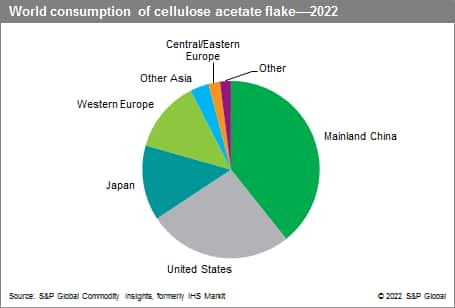Published September 2022.
This report covers cresols (o-, m-, and p-), xylenols (major types: 2,3-, 2,4-, 2,6-, 3,5-, and others), and cresylic acids. Cresols are monomethyl phenols either as mono- or mixed isomers ([o,m,p]-cresols), xylenols are dimethyl phenols either as mono- or mixed isomers, and cresylic acids are mixtures of both (cresols and xylenols), possibly with some higher alkylated phenols. These products are phenolic compounds or mixtures used as raw materials for a variety of synthetic applications, polymer intermediates, and also as solvents. Cresols and xylenols are obtained from a variety of sources. Generally, the two main avenues for obtaining cresols and/or xylenols are from natural sources (via coal tars, coal gasification extracts) or synthetic processes. Synthetic cresols and xylenols are produced by a variety of processes. Production of synthetic cresols and xylenols from toluene is considered the preferred route.
Global consumption of cresols, xylenols, and cresylic acids is expected to be around 557,000 metric tons in 2022. Annual average global growth is predicted to be 3.3% from 2022 to 2027.
The following pie chart shows world consumption of cresols, xylenols, and cresylic acids:

The major world consumers of cresols, xylenols, and cresylic acids are mainland China, the United States, Western Europe, Singapore, and Japan, together representing nearly 87% of world consumption in 2022.
Mainland China surpassed the United States and Western Europe in 2014 to become the largest global consumer. Asian markets such as mainland China, India, and South Korea are expected to show higher-thanaverage global rates over the forecast period.
For more detailed information, see the table of contents, shown below.
S&P Global’s Chemical Economics Handbook – Cresols, Xylenols, and Cresylic Acids is the comprehensive and trusted guide for anyone seeking information on this industry. This latest report details global and regional information, including Key

Key benefits
S&P Global’s Chemical Economics Handbook – Cresols, Xylenols, and Cresylic Acids has been compiled using primary interviews with key suppliers and organizations, and leading representatives from the industry in combination with S&P Global’s unparalleled access to upstream and downstream market intelligence and expert insights into industry dynamics, trade, and economics.
This report can help you
- Identify trends and driving forces influencing chemical markets
- Forecast and plan for future demand
- Understand the impact of competing materials
- Identify and evaluate potential customers and competitors
- Evaluate producers
- Track changing prices and trade movements
- Analyze the impact of feedstocks, regulations, and other factors on chemical profitability

















